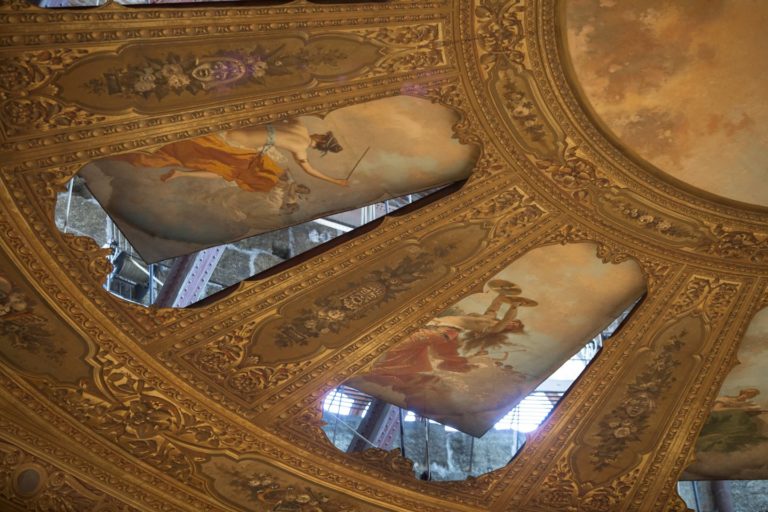THEATRE | Discovering Teatro Massimo in Palermo, the largest theatre in Italy
Palermo, the county seat of Sicily, offers the traveller numerous wonders of architecture, from the Arab-Norman to the Byzantine, and there is no lack of masterpieces that have evolved over time, in a fusion of different stylistic trends.
Every corner has something to offer, but the historic centre certainly holds architectural jewels of cultural and artistic interest, such as the Teatro Massimo Vittorio Emanuele, better known simply as Teatro Massimo.
The structure of the Teatro Massimo
The Massimo is the largest theatrical building in Italy and the third largest in Europe, after the Opéra National in Paris and the Staatsoper in Vienna.
The entire external structure features elements in neoclassical style, with references to Greek and Roman religious architecture: the front façade is made up of a pronaos of six Corinthian columns, raised on a staircase, on either side of which there are two bronze lion-shaped sculptures, allegories of Tragedy and Opera. The vault with the enormous hemispherical dome is also in neoclassical style and a system of rollers allows the temperature of the interior to be regulated.

The colossal dimensions of the theatre are due not only to the imposing monumental façade, but also to the set of halls, galleries and representative rooms that surround and complete the theatre itself.
The halls of the Massimo
The main hall, or Great Hall, has a horseshoe shape and contains five orders of 31 boxes each, in addition to the gallery. It has a capacity of 1247 seats and the hall boasts perfect acoustics. The stalls are overlooked by the Symbolic Wheel, a special ceiling composed of eleven wooden panels frescoed in the shape of a petal representing the “Triumph of Music” by Luigi Di Giovanni. The petals are mobile: a mechanism modulates their opening upwards, so that warm air can escape and guarantee excellent ventilation of the theatre in a natural way.

At the centre of the second tier of boxes is the so-called Palco Reale, designed by Ernesto Basile, with 27 seats and a private foyer: the “Salone del Sovrano“, embellished with mahogany coverings and a sumptuous Murano chandelier; red brocade armchairs and sofas complete the furnishings and 9 mirrors are fixed on the walls. On the doors and capitals is affixed the Savoy royal coat of arms.
The guided tour of the theatre also takes the visitor inside the Sala Pompeiana: the whole room is designed according to proportionality linked to the number 7 and its multiples. The symbolism of number 7 refers to the musical notes, the strings of the lyre, the days of the week and the deadly sins and Christian virtues.
Other rooms in the theatre include the Palco Bellini, once a meeting place and cultural circle, the Sala degli Stemmi, the Foyer and the Sala del Caffè.
Historical notes
Work began in 1875 and was led by architect Giovan Battista Filippo Basile, winner of the call for tenders issued in 1864. Upon his death, his son Ernesto Basile took over, who completed his father’s project at the request of the Municipality of Palermo.
The official opening of the theatre finally came on 16 May 1897 with Falstaff by Giuseppe Verdi, premiered in Palermo. This was followed by years of splendour and great performances, especially lyrical ones. In 1974 the theatre closed for restoration works: it remained abandoned for a very long period, until 1997, when it was finally reopened.
Curiosities about the Teatro Massimo
It is said that king Umberto I, on a visit to Palermo, did not want to enter the theatre during the inauguration, because he found inappropriate the presence of such a sumptuous building in a city he considered not to be as prominent as Palermo.
The Teatro Massimo was built by demolishing the church of San Francesco delle Stimmate and the convent of San Giuliano. During the demolition works, however, the tomb of the first Mother Superior of the convent would have been desecrated.
Legend has it that the restless soul of the nun, known as “la Monachella”, still wanders around the rooms of the theatre, casting curses. Many have claimed to have seen the shadow of a nun wandering behind the scenes or in the basement. Moreover, there is a particular step, entering the theatre, called “the Nun’s step”, in which it is said that all those who do not believe the legend stumble upon it.
The Sala Pompeiana, also called “Rotonda del Mezzogiorno“, was once reserved for men only. If you stand in the middle of the room and speak, you can hear your voice amplified out of all proportion; but to those who are in the rest of the room the sound arrives distorted, to the point of making the words incomprehensible. What is said at the centre of the Rotonda del Mezzogiorno is impossible for those outside to understand. This particular resonance effect is due to a slight asymmetry of the room, purposely intentional.
The Massimo is very close to the causes of the LGBT community: every year, during the week of the Pride celebrations, the columns of its façade are illuminated by the colours of the rainbow flag.

Tradotto da: https://archeome.it/teatro-alla-scoperta-del-massimo-di-palermo-il-piu-grande-ditalia/



